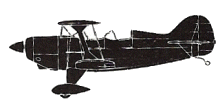
ASN Wikibase Occurrence # 221434
This information is added by users of ASN. Neither ASN nor the Flight Safety Foundation are responsible for the completeness or correctness of this information.
If you feel this information is incomplete or incorrect, you can submit corrected information.
| Date: | Tuesday 29 January 2019 |
| Time: | 05:52 UTC |
| Type: |  Aerotek Pitts S-2B Special |
| Owner/operator: | Private |
| Registration: | ZS-OOB |
| MSN: | 5030 |
| Fatalities: | Fatalities: 0 / Occupants: 1 |
| Aircraft damage: | Substantial |
| Category: | Accident |
| Location: | Near Brackenhurst, Alberton -
 South Africa South Africa
|
| Phase: | Manoeuvring (airshow, firefighting, ag.ops.) |
| Nature: | Private |
| Departure airport: | Johannesburg/Germiston-Rand Airport (QRA/FAGM) |
| Johannesburg/Germiston-Rand Airport (QRA/FAGM) | |
| Investigating agency: | CAA S.A. |
| Confidence Rating: |
A Pitts Special S-2B aircraft with registration mark ZS-OOB experienced an engine failure while returning to the Rand Aerodrome (FAGM) in Johannesburg after an aerobatic formation practise session in Kliprivier, Gauteng province. When the pilot was at about 500 feet (ft) above ground level (AGL), he heard a loud bang and saw smoke coming from the engine compartment. According to the pilot, oil splashed on the windshield before the engine stopped. The pilot carried out an emergency landing. The aircraft was landed hard and came to rest in a nose-down and left-wing low position. The aircraft was destroyed during the accident sequence as it landed hard on an uneven terrain, while the pilot sustained serious injuries.
The investigation revealed that there was no evidence of an oil change or screen cleaning every 25 hours as required by Mandatory Service Bulletin (MSB) No. 480F, mandated by the engine manufacturer on aircraft engaged in aerobatic manoeuvres. There was also no evidence of engine oil upliftment during operation. These two findings have led to the reduction in oil quantity, which resulted in the connecting rods and bearings overheating before failing and, thus, causing engine failure.
Probable cause/s and/or contributory factors
An unsuccessful forced landing following an in-flight engine failure caused by the failure of the No. 3 and No. 6 cylinder connecting rods as a result of overheating due to insufficient lubrication.
Accident investigation:
 |
|
Sources:
https://www.facebook.com/groups/iFlyafrica/permalink/10156012114148015/
https://www.jetphotos.com/photo/9120398 (photo)
Revision history:
| Date/time | Contributor | Updates |
|---|---|---|
| 01-Feb-2019 20:22 | Anon. | Added |
| 01-Feb-2019 20:23 | harro | Updated [Cn, Operator, Location, Narrative] |
| 01-Feb-2019 20:51 | RobertMB | Updated [Aircraft type, Location, Source, Narrative] |
| 05-Feb-2021 18:10 | harro | Updated [Time, Nature, Departure airport, Destination airport, Narrative, Category] |
Corrections or additions? ... Edit this accident description
The Aviation Safety Network is an exclusive service provided by:


 ©2024 Flight Safety Foundation
©2024 Flight Safety Foundation